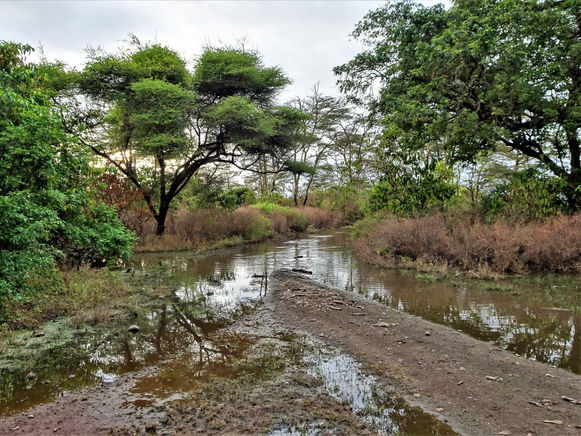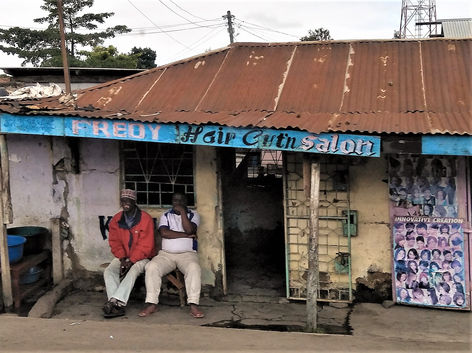
Lake Manyara National Park
Northern Circuit, Tanzania
Throughout the night I hear familiar environmental noises: traffic, dogs, roosters. No more wild animals for us. I can’t decide if this is a good thing or if I miss the possibly deadly creatures roaming by the tent.
It’s another 5.30 a.m. wake up call on our last day of safari. At 6.30 a.m. we leave camp, and ten minutes later we arrive at Lake Manyara National Park. We are the first visitors to arrive. The grey skies overhead don’t fill me with confidence that our final game drive will be a dry one.
As soon as we pass through the gate we enter a dense, wild forest - it is absolutely stunning. Danny and I agree that it would be a fantastic place to run through, if it weren’t for the lions, leopards and buffaloes. Baobab trees fill the slopes of the surrounding hills, their leafless branches standing out against the green foliage of the other trees. They seem more impressive, or maybe just more conspicuous, than at Tarangire. On the downside, it’s not an easy place to take photos, as the animals dart off into the thick vegetation as soon as they hear us coming.
Lake Manyara itself is flooded after the heavy wet season, limiting our movements significantly. We attempt driving down several side roads but the route quickly disappears under deep water, forcing us to turn back. Unfortunately we have to stick to the main road, which is not ideal for animal viewing.
Before long we encounter scores of baboons, who fill the roads, sit in the trees and chill by the river. They don't give us a second glance and instead concentrate intently on grooming each other. Danny picks out a blue monkey in amongst the pack, his long, dark tail clearly distinct to the baboon’s.

On our journey around the lake we also find:
-
Warthogs. Too quick for the camera.
-
Impala.
-
Our first bushbucks. They scare easily.
-
Elephants.
-
Several groups of giraffes. One of the baby giraffes doesn’t know what to make of us, and stands like a deer in the headlights as its parents trundle away.
-
Dik-diks. Super speedy, as always.
-
Black vervet monkeys.
-
Hammerkop bird. Apparently the shape of it’s head is reminiscent of a hammer. I don't see it.
-
Zebras.
-
Buffaloes, including the cutest fuzzy baby buffalo.
-
Waterbuck.

We stop at various viewpoints of the massive lake. It is brown and dirty-looking, and when combined with the blanket of grey clouds overhead it results in fairly mundane photos. Richard informs us the lake is only 3.7m deep, which seems unusually shallow for a body of water this vast. It is probably a little deeper now with the flooding.
For a moment we endure a patch of tsetse flies, followed by a patch of misty rain. Thankfully neither lasts long.
Our next point of interest is the normally-popular hot springs, but the long platform jutting out across the lake is completely submerged. The best we can do is walk down to where the thermal water is flowing out of the rocks on the edge of the lake. It is boiling hot, and stinks of sulphur.
On the road ahead of us we spy an elephant munching away on a tree. We pull up to watch him for a while, waiting to see if he will do anything exciting. As if reading our thoughts, he starts stomping down the road towards us and passes within a meter of our car. Our eyes are level with each other, so close we could reach out and touch him (of course we don’t). We stay deathly silent so as not to startle him. It is a tense, but incredible, moment.
Frustratingly, blue skies appear as we are leaving - it would have made the lake photos much more attractive. In the end we spent five hours in the park, for not a huge reward. There were long periods of time without seeing any animals, and we didn’t spot any of the tree-climbing lions that the park is famous for (or any other cats for that matter). The flooded roads restricting our access didn't help this matter. On the plus side, we had the place to ourselves, with only rangers for company, and the scenery was beautiful, a welcome contrast to the plains. Overall, though, I would have preferred less time here and more time at Tarangire.

Driving back to the campsite, Richard stops at a roadside stall to buy us red bananas. Dozens of women are selling yellow bananas but only a handful stock the red variety. Except for the pale red colour of the skin, it looks like a regular banana. The taste and texture, however, are noticeably different - less strong, more creamy. It’s not unpleasant, but I’m not ready to give up on the yellow variety yet.
On the way back to Moshi we pass through the city of Arusha, full of single-story rundown buildings with rusted iron roofs. It’s busy with street sellers offering almost everything: fruits and vegetables, popcorn, furniture, clothes, shoes and household items. Women skillfully balance large loads on their heads; one carries a pile of wood, another a massive bunch of bananas. Traffic is orderly and slow. There are tons of speed bumps, several police checkpoints but no horns. The highway is smooth and paved, yet most of the side streets are still made of dirt. It’s unlike most cities we have visited in our travels around the world.
Kilimanjaro is once again covered in cloud. I'm looking forward to actually seeing the famous mountain.
Arriving at the hotel we find our bags waiting for us. Relief! Here we say our thank yous and goodbyes to Richard and Dickson, then immediately we are introduced to our Kili trekking team. Our new guides give us a briefing for the next seven days (all I remember is more popcorn) and go through every single item of gear to ensure we aren't missing anything.
With the formal proceedings compete we go for a walk through Moshi. It is like a mini version of Arusha - motorbikes, tuk-tuks and dalla-dallas fight for space on the roads and street sellers take over the sidewalks. I feel as though I can buy anything from a roadside stall - all my food, clothing and household needs are readily available. Our only purchase is barbecued corn, which is quite chewy but tasty. I’m impressed that we are barely hassled at all, just a few hellos and one offer of a taxi.
It's hard to believe that our Northern Circuit safari has come to an end already. The experience was far beyond anything we could have ever imagined and we have so many wonderful memories to take with us. But now it's time to focus on the next stage of our holiday: conquering Kilimanjaro.




























